Charles E W Bean, Diaries, AWM38 3DRL 606/248/1 - 1917 - 1931 - Part 12

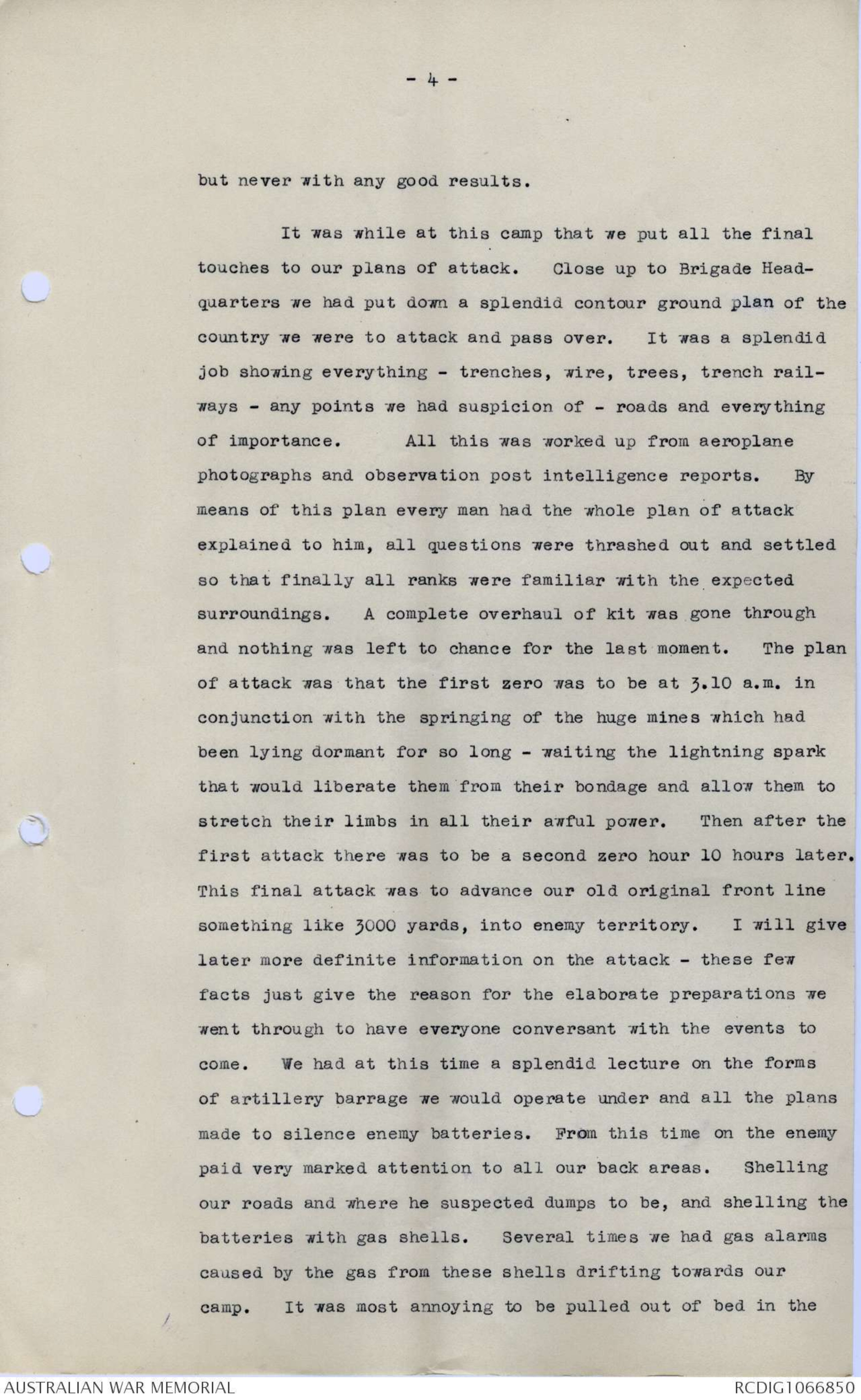
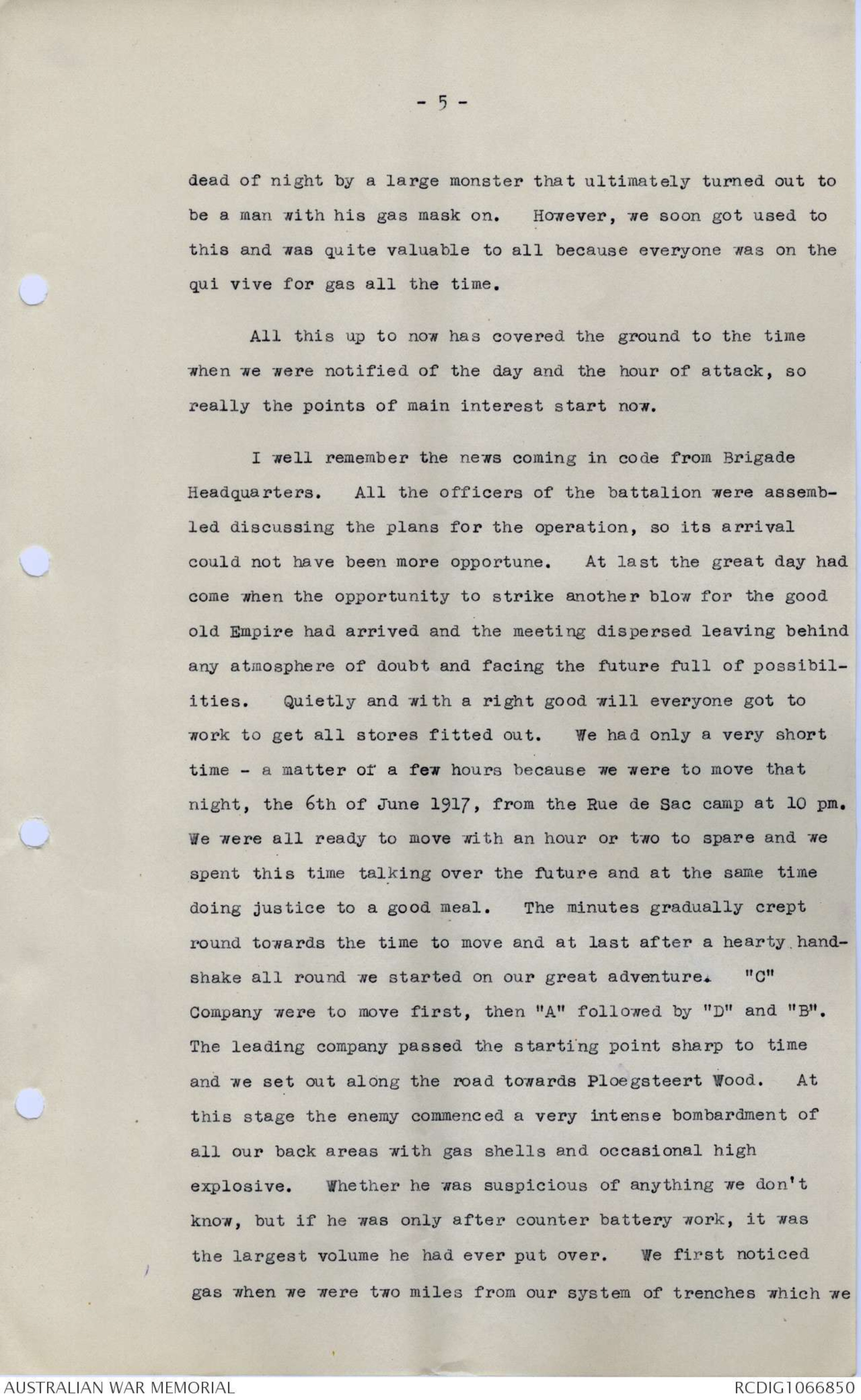
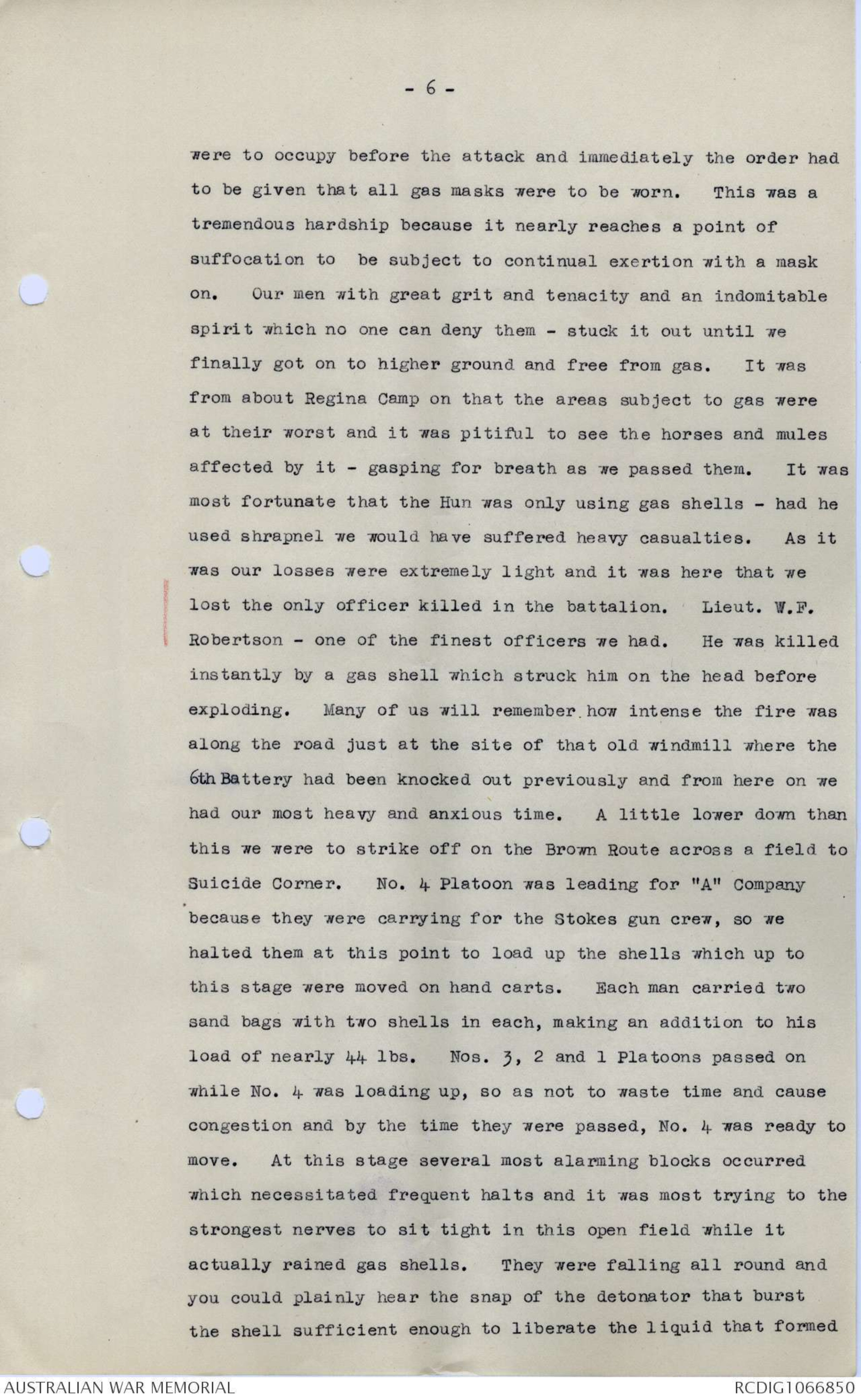
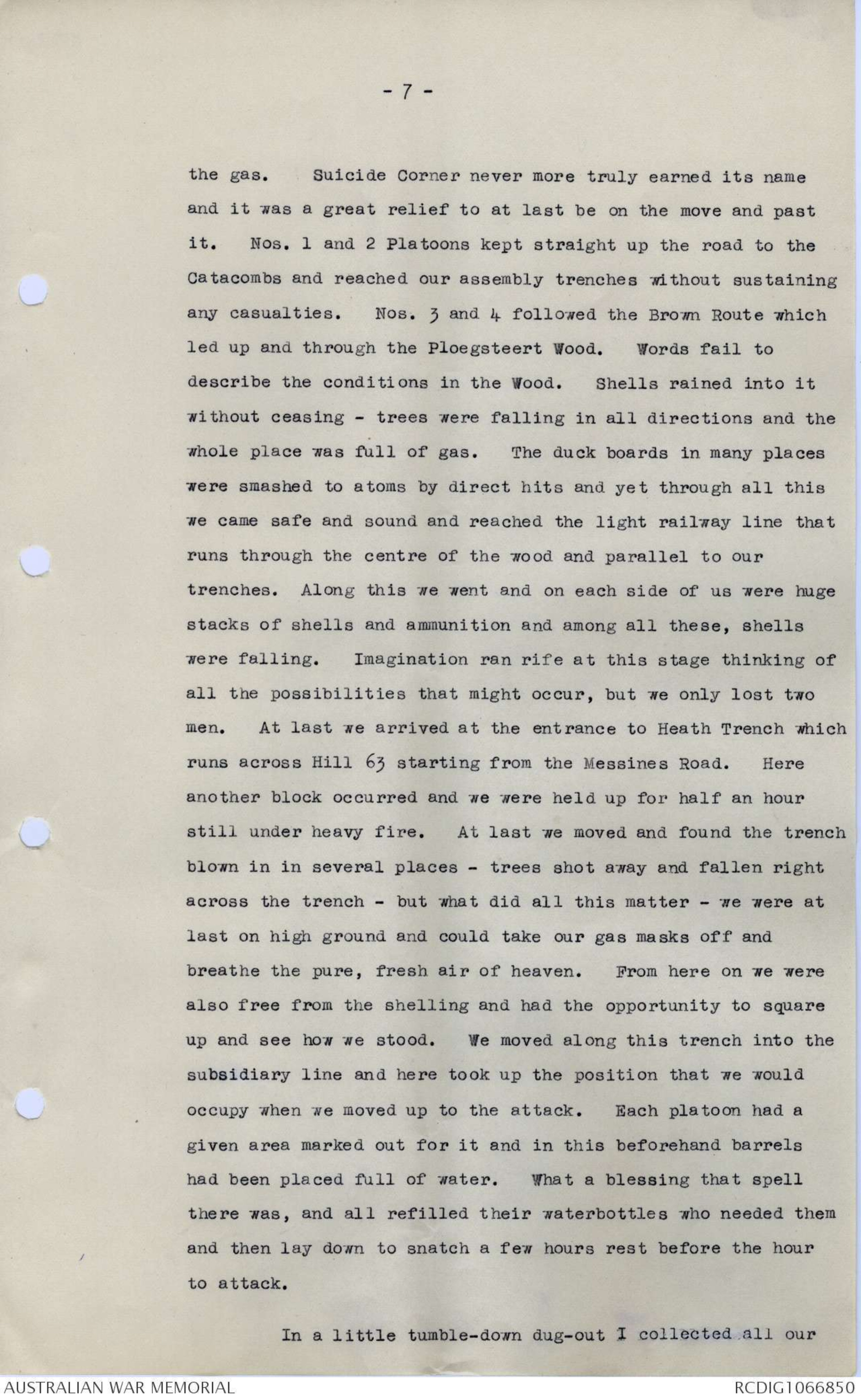
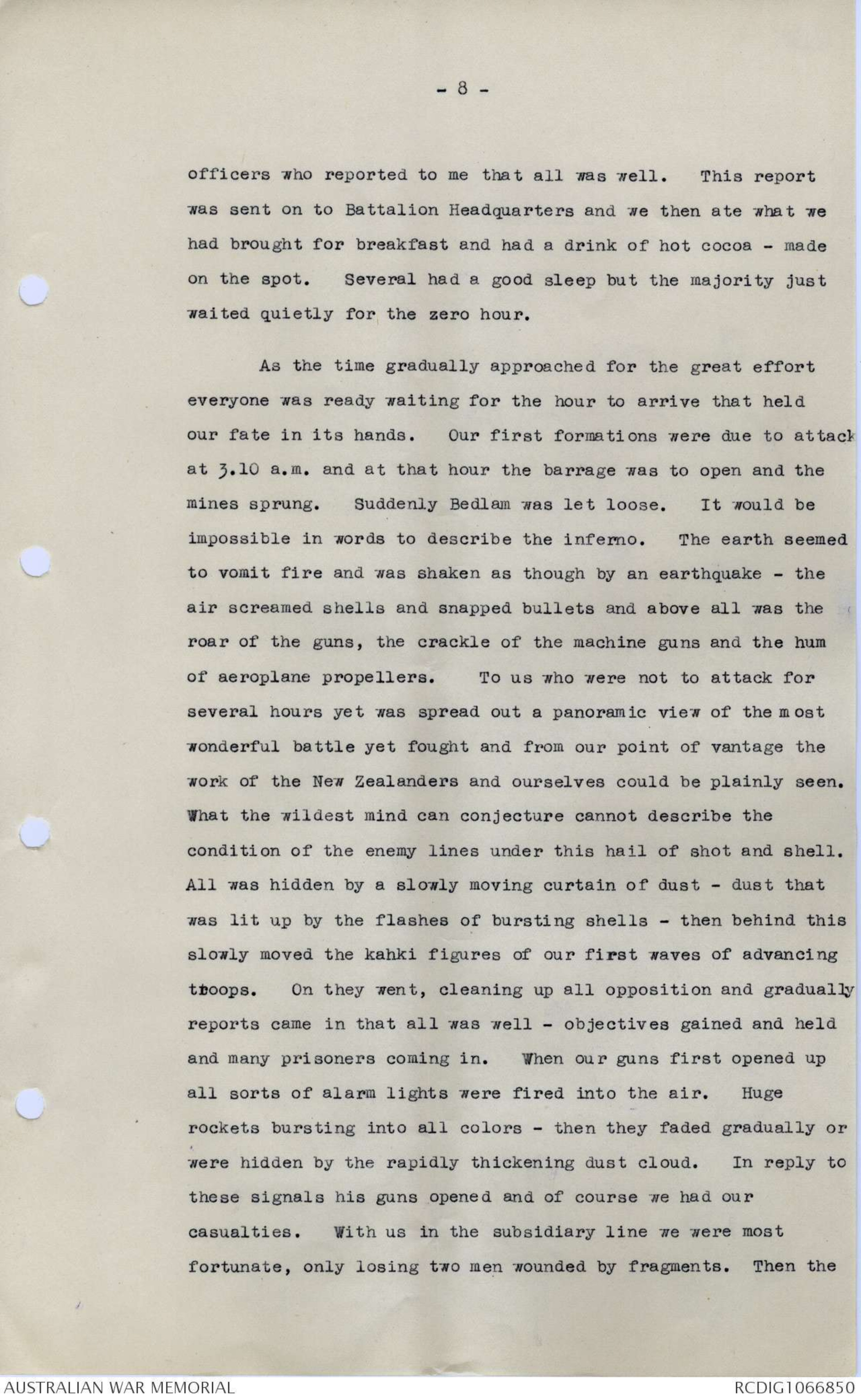
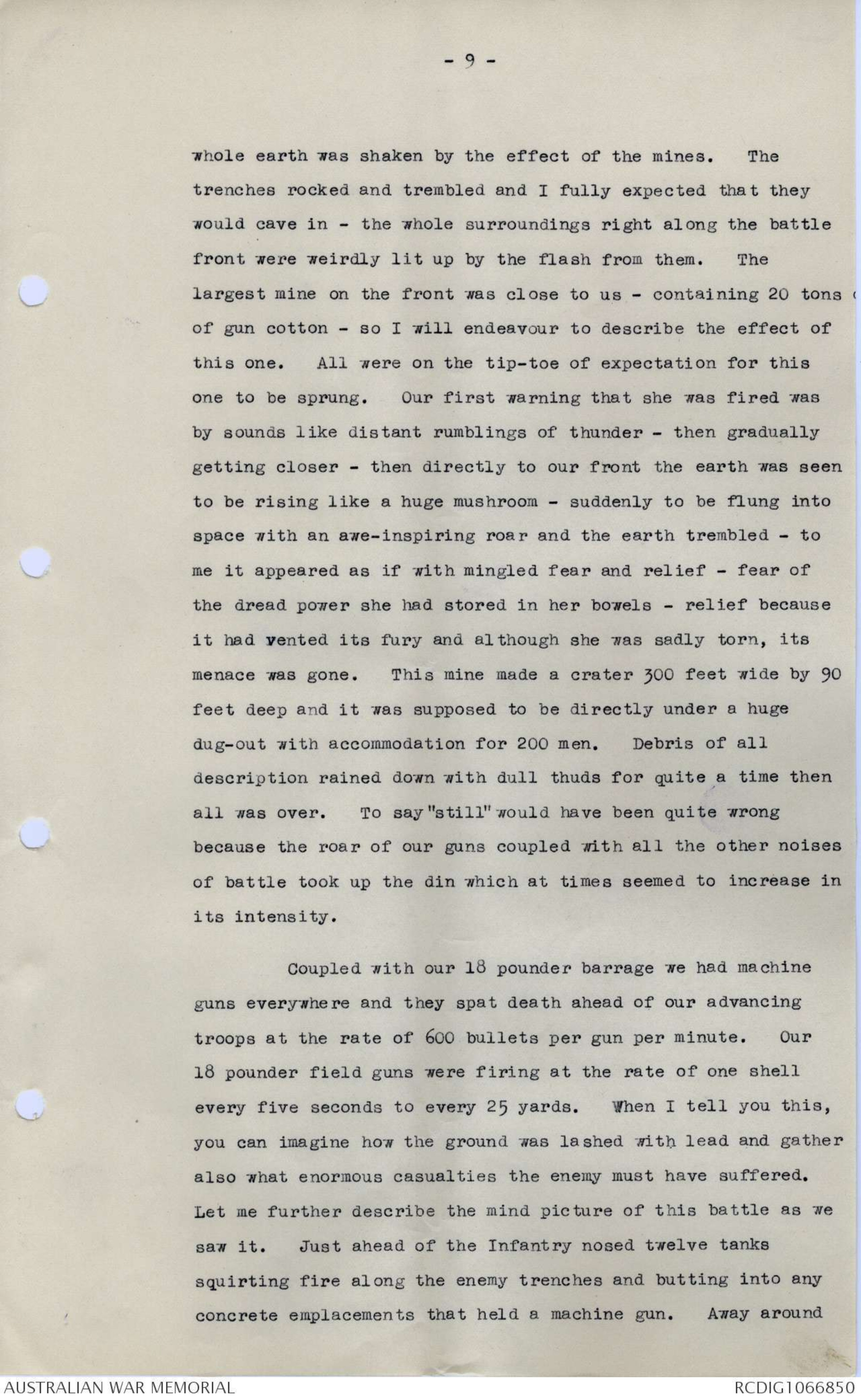

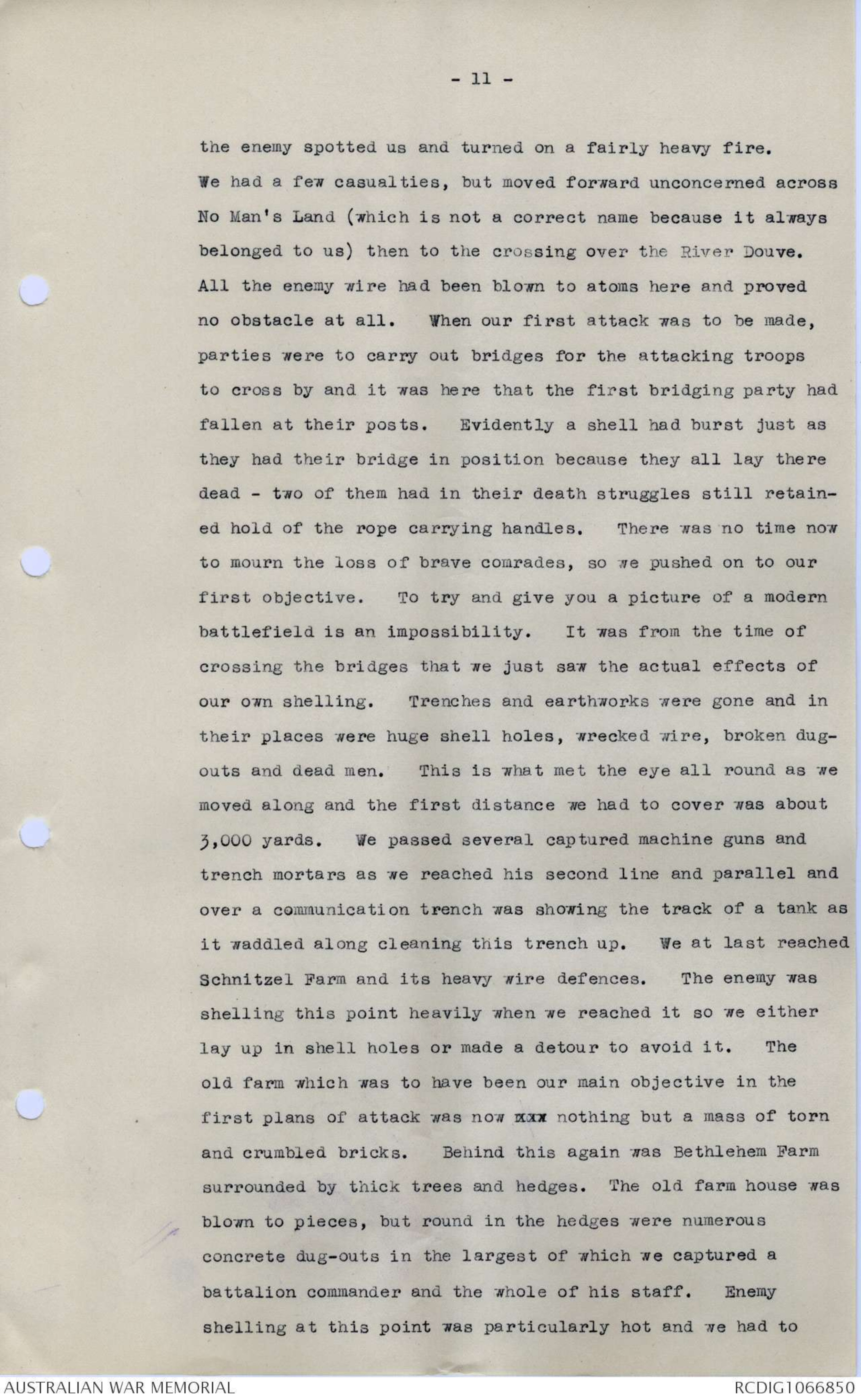
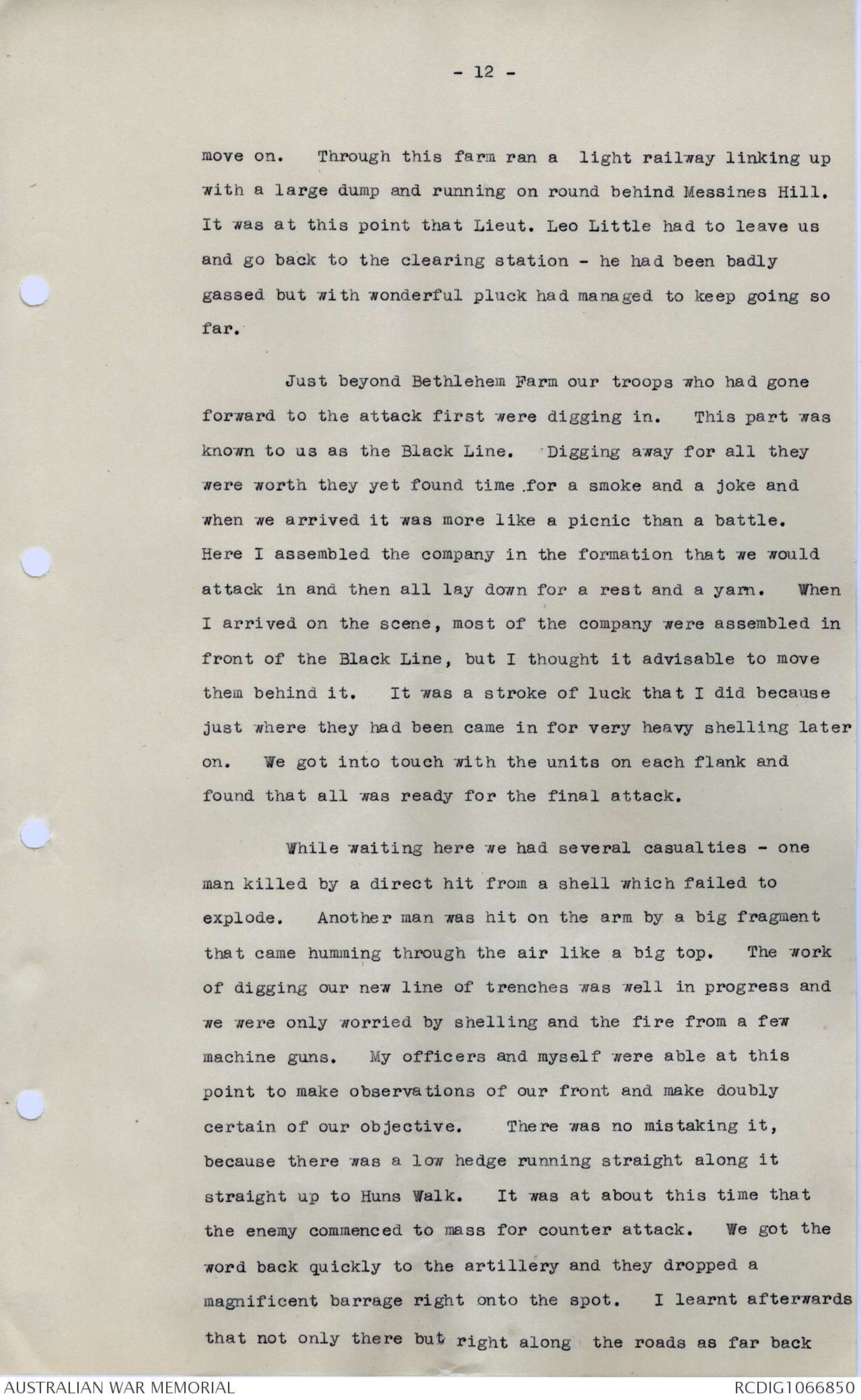
-3-
Ploegsteert Wood where we heard both the nightingale and the
cuckoo for the first time.
From Regina Camp we moved to Rue de Sac about another
1½ miles back. From this camp we made all our preparations for
the attack. The work of our aeroplanes at this stage was never
ceasing and their great daring and wonderful evolutions were a
source of constant amazement to all ranks. Behind us were our
observation balloons - the eyes of our guns. Shaped like a
huge sausage and anchored to a motor windlass by a steel hawser
these invaluable assets are carried on motor lorries and are put
up behind our various battle fronts. In this instance they
continued about 600 yards apart behind the whole of our battle
front. From daylight till dark they search the enemy's'
territory and anything that offers a target gets an unmerciful
time. These balloons greatly worry the Hun. He makes
constant and very daring efforts to destroy our eyes. His
aeroplanes fly over very high above the clouds and then dive
from space - firing when in a favorable position - sometimes
with good results - often unsuccessful - finally to be driven
off by the fire from our anti-aircraft guns which burst in
woolly puffs all round the hostile machine. It is a very
spectacular sight to see one of these balloons brought down in
flames. The observers leap for their lives and land safely by
means of their parachutes when the hostile machine approaches -
then when the tracer bullets do their work the balloon bursts
into flames and burns fiercely. All is over almost as soon as
it takes to describe it - a thin column of black smoke drifts
away - a few ashes reach the ground - all that remains of one
of our eyes. The balloon at Point Nieppe used to suffer most-
the main reason, I think, is because it was our most forward
one and was a point of great observation towards Lille. Next
day a new balloon would come up - quite unconcerned, ready to
be the means of scanning the enemy territory anew. Several
times the enemy tried for our balloons with a long range gun,
-4-
but never with any good results.
It was while at this camp that we put all the final
touches to our plans of attack. Close up to Brigade Headquarters
we had put down a splendid contour ground plan of the
country we were to attack and pass over. It was a splendid
job showing everything - trenches, wire, trees, trench railways
- any points we had suspicion of - roads and everything
of importance. All this was worked up from aeroplane
photographs and observation post intelligence reports. By
means of this plan every man had the whole plan of attack
explained to him, all questions were thrashed out and settled
so that finally all ranks were familiar with the expected
surroundings. A complete overhaul of kit was gone through
and nothing was left to chance for the last moment. The plan
of attack was that the first zero was to be at 3.10 a.m. in
conjunction with the springing of the huge mines which had
been lying dormant for so long - waiting the lightning spark
that would liberate them from their bondage and allow them to
stretch their limbs in all their awful power. Then after the
first attack there was to be a second zero hour 10 hours later
This final attack was to advance our old original front line
something like 3000 yards, into enemy territory. I will give
later more definite information on the attack - these few
facts just give the reason for the elaborate preparations we
went through to have everyone conversant with the events to
come. We had at this time a splendid lecture on the forms
of artillery barrage we would operate under and all the plans
made to silence enemy batteries. From this time on the enemy
paid very marked attention to all our back areas. Shelling
our roads and where he suspected dumps to be, and shelling the
batteries with gas shells. Several times we had gas alarms
caused by the gas from these shells drifting towards our
camp. It was most annoying to be pulled out of bed in the
- 5 -
dead of night by a large monster that ultimately turned out to
be a man with his gas mask on. However, we soon got used to
this and was quite valuable to all because everyone was on the
qui vive for gas all the time.
All this up to now has covered the ground to the time
when we were notified of the day and the hour of attack, so
really the points of main interest start now.
I well remember the news coming in code from Brigade
Headquarters. All the officers of the battalion were assembled
discussing the plans for the operation, so its arrival
could not have been more opportune. At last the great day had
come when the opportunity to strike another blow for the good
old Empire had arrived and the meeting dispersed leaving behind
any atmosphere of doubt and facing the future full of possibilities.
Quietly and with a right good will everyone got to
work to get all stores fitted out. We had only a very short
time - a matter of a few hours because we were to move that
night, the 6th of June 1917, from the Rue de Sac camp at 10 pm.
We were all ready to move with an hour or two to spare and we
spent this time talking over the future and at the same time
doing justice to a good meal. The minutes gradually crept
round towards the time to move and at last after a hearty, handshake
all round we started on our great adventure. "C"
Company were to move first, then "A" followed by "D" and "B".
The leading company passed the starting point sharp to time
and we set out along the road towards Ploegsteert Wood. At
this stage the enemy commenced a very intense bombardment of
all our back areas with gas shells and occasional high
explosive. Whether he was suspicious of anything we don't
know, but if he was only after counter battery work, it was
the largest volume he had ever put over. We first noticed
gas when we were two miles from our system of trenches which we
- 6 -
were to occupy before the attack and immediately the order had
to be given that all gas masks were to be worn. This was a
tremendous hardship because it nearly reaches a point of
suffocation to be subject to continual exertion with a mask
on. Our men with great grit and tenacity and an indomitable
spirit which no one can deny them - stuck it out until we
finally got on to higher ground and free from gas. It was
from about Regina Camp on that the areas subject to gas were
at their worst and it was pitiful to see the horses and mules
affected by it - gasping for breath as we passed them. It was
most fortunate that the Hun was only using gas shells - had he
used shrapnel we would have suffered heavy casualties. As it
was our losses were extremely light and it was here that we
lost the only officer killed in the battalion. Lieut. W.F.
Robertson - one of the finest officers we had. He was killed
instantly by a gas shell which struck him on the head before
exploding. Many of us will remember, how intense the fire was
along the road just at the site of that old windmill where the
6th Battery had been knocked out previously and from here on we
had our most heavy and anxious time. A little lower down than
this we were to strike off on the Brown Route across a field to
Suicide Corner. No. A Platoon was leading for "A" Company
because they were carrying for the Stokes gun crew, so we
halted them at this point to load up the shells which up to
this stage were moved on hand carts. Each man carried two
sand bags with two shells in each, making an addition to his
load of nearly 44 lbs. Nos. 3, 2 and 1 Platoons passed on
while No. 4 was loading up, so as not to waste time and cause
congestion and by the time they were passed, No. 4 was ready to
move. At this stage several most alarming blocks occurred
which necessitated frequent halts and it was most trying to the
strongest nerves to sit tight in this open field while it
actually rained gas shells. They were falling all round and
you could plainly hear the snap of the detonator that burst
the shell sufficient enough to liberate the liquid that formed
-7-
the gas. Suicide Corner never more truly earned its name
and it was a great relief to at last be on the move and past
it. Nos. 1 and 2 Platoons kept straight up the road to the
Catacombs and reached our assembly trenches without sustaining
any casualties. Nos. 3 and 4 followed the Brown Route which
led up and through the Ploegsteert Wood. Words fail to
describe the conditions in the Wood. Shells rained into it
without ceasing - trees were falling in all directions and the
whole place was full of gas. The duck boards in many places
were smashed to atoms by direct hits and yet through all this
we came safe and sound and reached the light railway line that
runs through the centre of the wood and parallel to our
trenches. Along this we went and on each side of us were huge
stacks of shells and ammunition and among all these, shells
were falling. Imagination ran rife at this stage thinking of
all the possibilities that might occur, but we only lost two
men. At last we arrived at the entrance to Heath Trench which
runs across Hill 63 starting from the Messines Road. Here
another block occurred and we were held up for half an hour
still under heavy fire. At last we moved and found the trench
blown in in several places - trees shot away and fallen right
across the trench - but what did all this matter - we were at
last on high ground and could take our gas masks off and
breathe the pure, fresh air of heaven. From here on we were
also free from the shelling and had the opportunity to square
up and see how we stood. We moved along this trench into the
subsidiary line and here took up the position that we would
occupy when we moved up to the attack. Each platoon had a
given area marked out for it and in this beforehand barrels
had been placed full of water. What a blessing that spell
there was, and all refilled their waterbottles who needed them
and then lay down to snatch a few hours rest before the hour
to attack.
In a little tumble-down dug-out I collected all our
- 8 -
officers who reported to me that all was well. This report
was sent on to Battalion Headquarters and we then ate what we
had brought for breakfast and had a drink of hot cocoa - made
on the spot. Several had a good sleep but the majority just
waited quietly for the zero hour.
As the time gradually approached for the great effort
everyone was ready waiting for the hour to arrive that held
our fate in its hands. Our first formations were due to attack
at 3.10 a.m. and at that hour the barrage was to open and the
mines sprung. Suddenly Bedlam was let loose. It would be
impossible in words to describe the inferno. The earth seemed
to vomit fire and was shaken as though by an earthquake - the
air screamed shells and snapped bullets and above all was the
roar of the guns, the crackle of the machine guns and the hum
of aeroplane propellers. To us who were not to attack for
several hours yet was spread out a panoramic view of the most
wonderful battle yet fought and from our point of vantage the
work of the New Zealanders and ourselves could be plainly seen.
What the wildest mind can conjecture cannot describe the
condition of the enemy lines under this hail of shot and shell.
All was hidden by a slowly moving curtain of dust - dust that
was lit up by the flashes of bursting shells - then behind this
slowly moved the kahki figures of our first waves of advancing
troops. On they went, cleaning up all opposition and gradually
reports came in that all was well - objectives gained and held
and many prisoners coming in. When our guns first opened up
all sorts of alarm lights were fired into the air. Huge
rockets bursting into all colors - then they faded gradually or
were hidden by the rapidly thickening dust cloud. In reply to
these signals his guns opened and of course we had our
casualties. With us in the subsidiary line we were most
fortunate, only losing two men wounded by fragments. Then the
- 9 -
whole earth was shaken by the effect of the mines. The
trenches rocked and trembled and I fully expected that they
would cave in - the whole surroundings right along the battle
front were weirdly lit up by the flash from them. The
largest mine on the front was close to us - containing 20 tons
of gun cotton - so I will endeavor to describe the effect of
this one. All were on the tip-toe of expectation for this
one to be sprung. Our first warning that she was fired was
by sounds like distant rumblings of thunder - then gradually
getting closer - then directly to our front the earth was seen
to be rising like a huge mushroom - suddenly to be flung into
space with an awe-inspiring roar and the earth trembled - to
me it appeared as if with mingled fear and relief - fear of
the dread power she had stored in her bowels - relief because
it had vented its fury and although she was sadly torn, its
menace was gone. This mine made a crater 300 feet wide by 90
feet deep and it was supposed to be directly under a huge
dug-out with accommodation for 200 men. Debris of all
description rained down with dull thuds for quite a time then
all was over. To say "still" would have been quite wrong
because the roar of our guns coupled with all the other noises
of battle took up the din which at times seemed to increase in
its intensity.
Coupled with our 18 pounder barrage we had machine
guns everywhere and they spat death ahead of our advancing
troops at the rate of 600 bullets per gun per minute. Our
18 pounder field guns were firing at the rate of one shell
every five seconds to every 25 yards. When I tell you this,
you can imagine how the ground was lashed with lead and gather
also what enormous casualties the enemy must have suffered.
Let me further describe the mind picture of this battle as we
saw it. Just ahead of the Infantry nosed twelve tanks
squirting fire along the enemy trenches and butting into any
concrete emplacements that held a machine gun. Away around
- 10 -
the northern end of Messines Ridge and travelling along Huns
Walk, surged about 600 Cavalry. Along the road they dashed
into action and it again looked like a war of movement. The
New Zealanders attacked the Messines Ridge and they looked
like ants as they swarmed up the face of the hill - through
and round the ruined houses that every now and again seemed
to vanish into clouds of black-red dust as an enemy shell
landed with a crump into them. Behind us in the air like
so many huge grubs were dozens of our observation balloons -
watching results and eagerly searching for targets for our
batteries. As the sun rose, right in the orb appeared a tiny
grub. This was the only balloon the enemy had up. Later
on it was put down in flames by one of our airmen. During
the morning he again attempted to put another balloon up but
owing to some accident or fear that he had - it bolted and
blew away behind his lines and was lost to sight. Long
before daylight, several of our aeroplanes were patrolling
our front and as dawn approached they seemed to be coming
from everywhere. Daylight revealed to us the air full of
our machines, some flying high till they just looked like
bees - others flying low over the enemy trenches firing at
his infantry - so low that you expected to see them shot down
any moment. Then with daylight appeared the ominous black
puffs around them - from the enemy anti aircraft guns. Early
in the fight one of our machines had its tail cut off by one
of our own shells - but managed to land safely just in front
of the trenches where we were assembled. I fully expected
that the enemy in attempting to shell it, would shell us, but
fortunately all his attention was attracted elsewhere.
At last our time came to move and all our energies
had to be concentrated on our own particular part. Moving
by platoons in file from our trenches we went through gaps
in our own wire and advanced towards our own front line.
All this area was cut up by shell fire and as we moved forward
- 11 -
the enemy spotted us and turned on a fairly heavy fire.
We had a few casualties, but moved forward unconcerned across
No Man's Land (which is not a correct name because it always
belonged to us) then to the crossing over the River Douve.
All the enemy wire had been blown to atoms here and proved
no obstacle at all. When our first attack was to be made,
parties were to carry out bridges for the attacking troops
to cross by and it was here that the first bridging party had
fallen at their posts. Evidently a shell had burst just as
they had their bridge in position because they all lay there
dead - two of them had in their death struggles still retained
hold of the rope carrying handles. There was no time now
to mourn the loss of brave comrades, so we pushed on to our
first objective. To try and give you a picture of a modern
battlefield is an impossibility. It was from the time of
crossing the bridges that we just saw the actual effects of
our own shelling. Trenches and earthworks were gone and in
their places were huge shell holes, wrecked wire, broken dugouts
and dead men. This is what met the eye all round as we
moved along and the first distance we had to cover was about
3,000 yards. We passed several captured machine guns and
trench mortars as we reached his second line and parallel and
over a communication trench was showing the track of a tank as
it waddled along cleaning this trench up. We at last reached
Schnitzel Farm and its heavy wire defences. The enemy was
shelling this point heavily when we reached it so we either
lay up in shell holes or made a detour to avoid it. The
old farm which was to have been our main objective in the
first plans of attack was now xxx nothing but a mass of torn
and crumbled bricks. Behind this again was Bethlehem Farm
surrounded by thick trees and hedges. The old farm house was
blown to pieces, but round in the hedges were numerous
concrete dug-outs in the largest of which we captured a
battalion commander and the whole of his staff. Enemy
shelling at this point was particularly hot and we had to
- 12 -
move on. Through this farm ran a light railway linking up
with a large dump and running on round behind Messines Hill.
It was at this point that Lieut. Leo Little had to leave us
and go back to the clearing station - he had been badly
gassed but with wonderful pluck had managed to keep going so
far.
Just beyond Bethlehem Farm our troops who had gone
forward to the attack first were digging in. This part was
known to us as the Black Line. Digging away for all they
were worth they yet found time for a smoke and a joke and
when we arrived it was more like a picnic than a battle.
Here I assembled the company in the formation that we would
attack in and then all lay down for a rest and a yarn. When
I arrived on the scene, most of the company were assembled in
front of the Black Line, but I thought it advisable to move
them behind it. It was a stroke of luck that I did because
just where they had been came in for very heavy shelling later
on. We got into touch with the units on each flank and
found that all was ready for the final attack.
While waiting here we had several casualties - one
man killed by a direct hit from a shell which failed to
explode. Another man was hit on the arm by a big fragment
that came humming through the air like a big top. The work
of digging our new line of trenches was well in progress and
we were only worried by shelling and the fire from a few
machine guns. My officers and myself were able at this
point to make observations of our front and make doubly
certain of our objective. There was no mistaking it,
because there was a low hedge running straight along it
straight up to Huns Walk. It was at about this time that
the enemy commenced to mass for counter attack. We got the
word back quickly to the artillery and they dropped a
magnificent barrage right onto the spot. I learnt afterwards
that not only there but right along the roads as far back
 Sandy Mudie
Sandy MudieThis transcription item is now locked to you for editing. To release the lock either Save your changes or Cancel.
This lock will be automatically released after 60 minutes of inactivity.